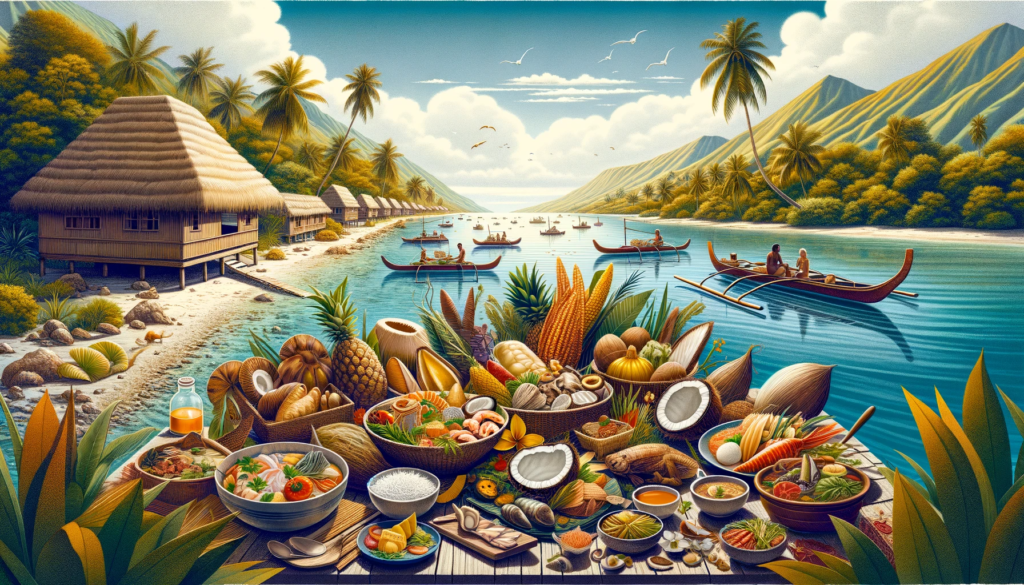Introduction to the Culinary Traditions of the Marshall Islands
The Unique Blend of Flavors in Marshallese Cuisine
Marshallese cuisine presents a fascinating amalgamation of tastes shaped by the island’s rich cultural heritage and bountiful natural resources. The traditional flavors are characterized by the subtle use of spices, the prominence of fresh seafood, and the heavy reliance on coconut, breadfruit, and other tropical fruits. This unique flavor profile is influenced by the available local ingredients, historical trade routes that brought new culinary elements, and the traditional customs passed down through generations.
Staple Ingredients in Marshallese Cooking
The Prominence of Seafood, Breadfruit, and Coconuts
Seafood is the cornerstone of the Marshallese diet, with fish like tuna playing a significant role. Breadfruit is revered for its versatility and as a sustenance staple. At the same time, coconuts are indispensable, serving as the foundation for various dishes, from savory entrees to sweet desserts. These key ingredients embody the essence of island cooking and testify to the Marshallese people’s connection with their environment.
Local Vegetables and Fruits in Traditional Dishes
Aside from the core ingredients, Marshallese cooking also incorporates an array of local vegetables and fruits. Root vegetables like taro and sweet potatoes are standard, along with different varieties of bananas and pandanus fruit. These items enrich the dishes with nutrients and add complexity to the palate, allowing locals to enjoy a diverse range of flavors all year round.
Iconic Traditional Dishes of the Marshall Islands
Marshallese Fish and Coconut Milk Curry
Their fish and coconut milk curry are staple dishes that symbolize the Marshallese culinary identity. This hearty dish utilizes fresh, locally caught fish simmered in a rich coconut milk sauce often infused with turmeric and other spices, making it both nourishing and comforting.
Bokbok – A Sun-Dried Fish Specialty
Bokbok, a traditional sun-dried fish delicacy, captures the ingenuity of indigenous preservation techniques. The preparation involves cleaning and salting the fish before it dries under the tropical sun. Bokbok is lauded not only for its storability but also for its intense flavor, which enhances any meal.
Breadfruit in Various Forms – From Savory to Sweet
Breadfruit’s versatility is displayed in Marshallese cuisine, transforming from a savory, starch-filled side akin to potatoes to a sweetened treat reminiscent of the most indulgent pastries. This diversity has solidified breadfruit’s status as an integral part of the Marshallese diet.
Pandanus Dessert – A Unique Fruit-Based Treat
The pandanus dessert offers a unique tasting experience with its distinct nutty and sweet flavor profile. By utilizing the pandanus fruit, which is native to the Marshall Islands, this dessert showcases the natural bounty of the land while delivering an exquisite sensory delight.

Traditional Cooking Techniques of the Marshall Islands
The Use of Earth Ovens and Open Flame Cooking
Traditional Marshallese cooking techniques are rooted in simplicity and the use of what’s abundantly available. Earth ovens, known locally as ums, are a typical cooking method where food is wrapped in leaves and slow-cooked over heated rocks, while open flame cooking is prevalent for its straightforward yet effective approach.
Preservation Methods like Smoking and Drying
Given the tropical climate of the Marshall Islands, traditional food preservation methods, such as smoking and drying, are essential for ensuring a stable food supply. These methods extend the shelf-life of valuable protein sources like fish and infuse them with a subtle smokiness that adds depth to their flavor.
The Role of Food in Marshallese Culture and Celebrations
Communal Feasts and the Significance of Food in Ceremonies
In the Marshallese culture, communal feasts serve as gatherings for nourishment and as cornerstones of social and ceremonial life. Food is deeply interwoven with tradition, underscoring the importance of shared meals in fostering community bonds and marking significant life events.
The Cultural Symbolism of Certain Dishes
Specific Marshallese dishes carry cultural symbolism and are integral to the authenticity of an event or celebration. For instance, certain seafood and root vegetables are reserved for honored guests or special occasions and are a key part of the cultural narrative and legacy of the islands.
Modern Influences on Marshallese Cuisine

Fusion of Traditional and Contemporary Culinary Styles
The influence of foreign culinary styles has led to an intriguing fusion of traditional and contemporary Marshallese cuisine. Chefs and home cooks alike are now blending indigenous ingredients with modern techniques and flavors, creating an evolving food landscape while preserving the essence of Marshallese tradition.
Adaptation of Marshallese Dishes in Modern Kitchens
Adapting traditional Marshallese dishes in modern kitchens is a testament to their timeless appeal and the versatility of the recipes. While remaining rooted in the cultural heritage, these dishes are being tweaked to suit contemporary palates and dietary preferences, thus ensuring their continuity in the culinary world.
Nutritional Aspects of Traditional Marshallese Diet
Health Benefits of Indigenous Ingredients and Cooking Methods
The traditional Marshallese diet, rich in fresh seafood, tropical fruits, and root vegetables, is flavorful and boasts various health benefits. The minimalist cooking methods, such as grilling and steaming, preserve the ingredients’ nutritional integrity, ensuring a diet conducive to good health.
Preparing Marshallese Dishes at Home
Recipes and Tips for Traditional Marshallese Cooking
Embarking on preparing Marshallese dishes at home is a highly rewarding experience. Traditional recipes can be adapted for the modern kitchen, and with a few tips and guidance, anyone can recreate the vibrant flavors of the Marshall Islands right in their own home.
FAQs on Traditional Food in the Marshall Islands
Common Questions About Marshallese Cuisine and Cooking Practices
Understanding Marshallese cuisine goes beyond enjoying its tastes; it involves exploring the cultural context and the cooking practices that make it unique. Here, we answer some common questions that arise when delving into the rich culinary traditions of the Marshall Islands.
FAQs on Traditional Food in the Marshall Islands
What are the most popular dishes in the Marshall Islands?
Popular dishes of the Marshall Islands typically center around fresh seafood and local produce. Marshallese fish and coconut milk curry, grilled fish, and kukuruk – chicken wrapped in breadfruit leaves – are among the favorites. Another beloved preparation is the pandanus dessert, a unique delicacy showcasing the tropical pandanus fruit.
How does Marshallese cuisine differ from other Pacific Island foods?
While there are similarities in the ingredients used across Pacific Island foods, Marshallese cuisine is distinguished by its particular use of breadfruit and pandanus and the preferred methods of food preservation like smoking and drying fish. Additionally, the communal meal preparation and consumption separate Marshallese culinary practices.
Can I find the ingredients for Marshallese dishes locally?
It depends on where you reside. Some ingredients like breadfruit and fresh seafood may be available in regions with tropical climate. For others living in temperate zones, substitutions may be necessary, and some specialty ingredients could be sourced from Asian or Pacific Islander markets or online stores specializing in exotic produce.
Are there any vegetarian options in Marshallese cuisine?
Yes, Marshallese cuisine includes vegetarian options, emphasizing the rich variety of fruits and vegetables available on the islands. Dishes like breadfruit salads, curries made with local greens, and desserts utilizing coconut and fruits like pandanus offer delightful vegetarian fare.
How can I make a traditional Marshallese meal at home?
To make a traditional Marshallese meal at home, start by sourcing the freshest ingredients possible and follow authentic recipes, which can be found in cultural cookbooks or online. Embrace the simplicity of grilling and steaming and enjoy the process of creating dishes rich in flavor and tradition.
